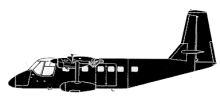Incident Overview

Description
The pilot reported that shortly after take-off on the seventh parachuting flight for the day the left engine fuel low pressure warning light illuminated. Activation of the auxiliary pump did not rectify the problem and the engine stopped. Following completion of the left engine shutdown drills and an apparent inability to outclimb the rising terrain, the pilot elected to shut down the right engine and land in a paddock. Landing gear extension had just commenced when the aircraft impacted the ground. The aircraft groundlooped to the left in the landing slide. As the parachuting operation involved climbing to 12000 feet, to enhance climb performance and minimise sortie time, minimum fuel was carried. The pilot and the operator considered that the regulations relating to fuel reserve requirements did not apply to parachuting operations. The planned fuel for the flight was therefore substantially less than statutory requirements. A complete fuel drain and quantity check revealed only 19.5 lbs (11 litres) of fuel remained in the left tank and 231 lbs (130 litres) in the right. The amount of fuel burned since the last refuel was 24 lbs (13.5 litres). The inspection of the aircraft fuel system revealed that the fuel quantity indication system was defective. The left outer fuel quantity sender unit was unserviceable and showed a reading on the left outer fuel gauge of 100 lbs and empty on the left inboard gauge when both the inboard and outboard fuel tanks were completely empty. The pilot was unaware of the significance of this fuel gauge indication anomaly. All fuel pumps were serviceable and both engines were found to be capable of operating throughout the design power range. The wind at the time was south-easterly at 10 knots gusting to 15 knots. The into-wind takeoff was over rising terrain with a 5-7 knot crosswind from the left. It is considered that during the initial climb phase of the flight insufficient fuel remained to cover the left fuel pumps and outlet ports, effectively starving the left engine of fuel. No reason could be found for the inability of the aircraft to outclimb the terrain on the remaining engine. Performance tests revealed that, at worst, the aircraft would have been capable of maintaining level flight following the failure of the left engine. It is probable that the visual illusion caused by the rising ground on the initial climb track induced the pilot to assume that the aircraft was descending. Significant Factors: The following factors were considered relevant to the development of the accident 1. The pilot’s knowledge of the aircraft systems was inadequate. 2. The fuel quantity in the left fuel tanks was inadequate to ensure continued operation of the left engine. 3. The left engine failed due to fuel starvation. 4. It is probable that a visual illusion caused the pilot to believe the aircraft was descending, and consequently, to abandon the takeoff.
Primary Cause
Defective fuel quantity indication system on the left outer fuel quantity sender unit.Defective fuel quantity indication system on the left outer fuel quantity sender unit.Share on:




